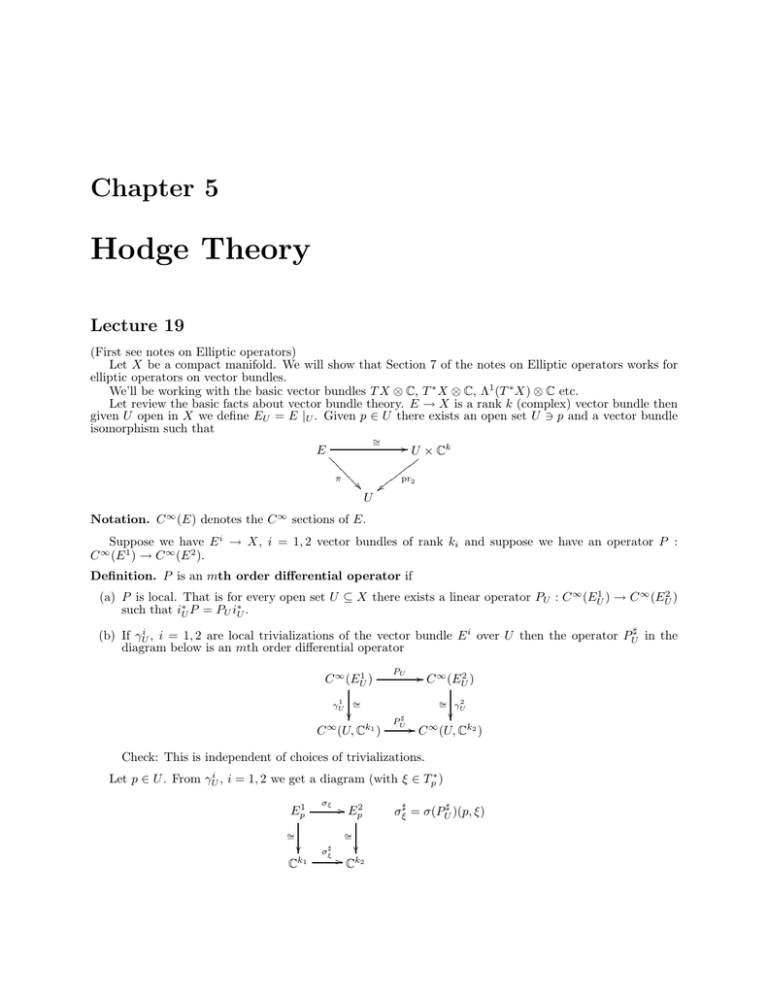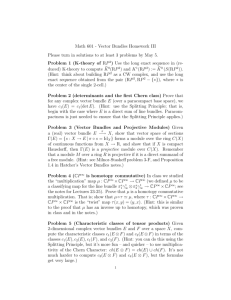Document 13570235
advertisement

Chapter 5 Hodge Theory Lecture 19 (First see notes on Elliptic operators) Let X be a compact manifold. We will show that Section 7 of the notes on Elliptic operators works for elliptic operators on vector bundles. We’ll be working with the basic vector bundles T X ⊗ C, T ∗ X ⊗ C, Λ1 (T ∗ X) ⊗ C etc. Let review the basic facts about vector bundle theory. E → X is a rank k (complex) vector bundle then given U open in X we define EU = E |U . Given p ∈ U there exists an open set U ∋ p and a vector bundle isomorphism such that ∼ = � U × Ck E� �� � �� �� ��pr � π ��� � ���� 2 U Notation. C ∞ (E) denotes the C ∞ sections of E. Suppose we have E i → X, i = 1, 2 vector bundles of rank ki and suppose we have an operator P : C (E 1 ) → C ∞ (E 2 ). ∞ Definition. P is an mth order differential operator if (a) P is local. That is for every open set U ⊆ X there exists a linear operator PU : C ∞ (EU1 ) → C ∞ (EU2 ) ∗ . such that i∗U P = PU iU (b) If γUi , i = 1, 2 are local trivializations of the vector bundle E i over U then the operator PU♯ in the diagram below is an mth order differential operator C ∞ (EU1 ) PU U 1 ∼ γU = � C ∞ (U, Ck1 ) � C ∞ (E 2 ) 2 ∼ = γU ♯ PU � � C ∞ (U, Ck2 ) Check: This is independent of choices of trivializations. Let p ∈ U . From γUi , i = 1, 2 we get a diagram (with ξ ∈ Tp∗ ) Ep1 ∼ = � Ck1 σξ σξ♯ � Ep2 ∼ = � � Ck2 σξ♯ = σ(PU♯ )(p, ξ) Definition. σξ = σ(P )(p, ξ) Check that this is independent of trivialization. f ∈ C ∞ (U ), s ∈ C ∞ (EU ). Then (e−itf P eitf)(p) = tm σ(P )(p, ξ)s(p) + O(tm−1 ) where ξ = dfp . Definition. P is elliptic if k1 = k2 and for every p and ξ �= 0 in Tp X, then σ(P )(p, ξ) : Ep1 → Ep2 is bijective. 5.0.1 Smoothing Operators on Vector Bundles We have bundles E i → X. Form a bundle Hom(E 1 , E 2 ) → X × X by defining that at (x, y) the fiber of this bundle is Hom(Ex1 , Ey2 ). In addition lets let dx be the volume form on X. Let K ∈ C ∞ (Hom(E 1 , E 2 )) and define TK : C ∞ (E 1 ) → C ∞ (E 2 ), with f ∈ C ∞ (E 1 ) by � TK f (y) = K(x, y)f (x)dx 1 What does this mean? By definition f (x) ∈ Ex and K(x, y) : Ex1 → Ey2 , so (K(x, y)f (x)) ∈ Ey2 . Thus it makes perfect sense to do the integration in the definition. Theorem. P : C ∞ (E 1 ) → C ∞ (E 2 )is an mth order elliptic differential operator, then there exists an “mth order ΨDO”, Q : C ∞ (E 2 ) → C ∞ (E 1 ) such that P Q − I is smoothing. Proof. Just as proof outlined in notes with Ui , ρi , γi . But make sure that E 1 , E 2 are locally trivial over Ui , ♯ ♯ i.e. on Ui , PUi ∼ = PUi , so PUi is an elliptic system. 5.0.2 Fredholm Theory in the Vector Bundle Setting Let E → X be a complex vector bundle. Then a hermitian inner product on E is a smooth function X ∋ p → (, )p where (, )p is a Hermitian inner product on Ep . If X is compact with s1 , s2 ∈ C ∞ (E) then we can make this into a compact pre-Hilbert space by defining an L2 inner product � �s1 , s2 � = (s1 (x), s2 (x))dx Lemma. Given p ∈ X, there exists a neighborhood U of p and a Hermitian trivialization of EU EU � �� �� �� �� γU U � U × Ck � �� �� � � ��� ∼ Ck is an isomorphism of hermitian vector spaces. for p ∈ U , Ep ∼ = Ck and γU hermitian if Ep = Proof. This is just Graham-Schmidt Theorem. E i → X, i = 1, 2 Hermitian vector bundles and P : C ∞ (E 1 ) → C ∞ (E 2 ) an mth order DO, then there exists a unique mth order DO, P t : C ∞ (E 2 ) → C ∞ (E 1 ) such that for f ∈ C ∞ (E 1 ), g ∈ C ∞ (E 2 ) �P f, g�L2 = �f, P t g �L2 Proof. (Using the usual mantra: local existence, local uniqueness implies global existence global uniqueness). 2 So we’ll first prove local existence. Let U be open and γU1 , γU hermitian trivialization of EU1 , EU2 . P ! PU♯ , ♯ ♯ PU : C ∞ (U, Ck1 ) → C ∞ (U, Ck2 ). Then PU = [Pij ], Pij : C ∞ (U ) → C ∞ (U ), 1 ≤ i ≤ k2 , 1 ≤ j ≤ k1 . PUt . Then PUt : C ∞ (EU2 ) → C ∞ (EU1 ). Set (PUt )♯ = [Pjit ], (PUt )♯ We leave the read to check that if f ∈ C0∞ (EU1 ), g ∈ C0∞ (EU2 ) then �PU f, g � = �f, PUt g � This is local existence. Local uniqueness is trivial. This all implies global existence. Theorem (Main Theorem). X compact, E i → X, i = 1, 2 hermitian bundles of rank k. And P : C ∞ (E 1 ) → C ∞ (E 2 ) an m order elliptic DO then (a) ker P is finite dimensional (b) f ∈ Im P if and only if �f, g � = 0 for all g ∈ ker P t . Proof. The proof is implied by existence of right inverses for P modulo smoothing and the Fredholm Theorem for I − T when T : C ∞ (E 1 ) → C ∞ (E 2 ).


